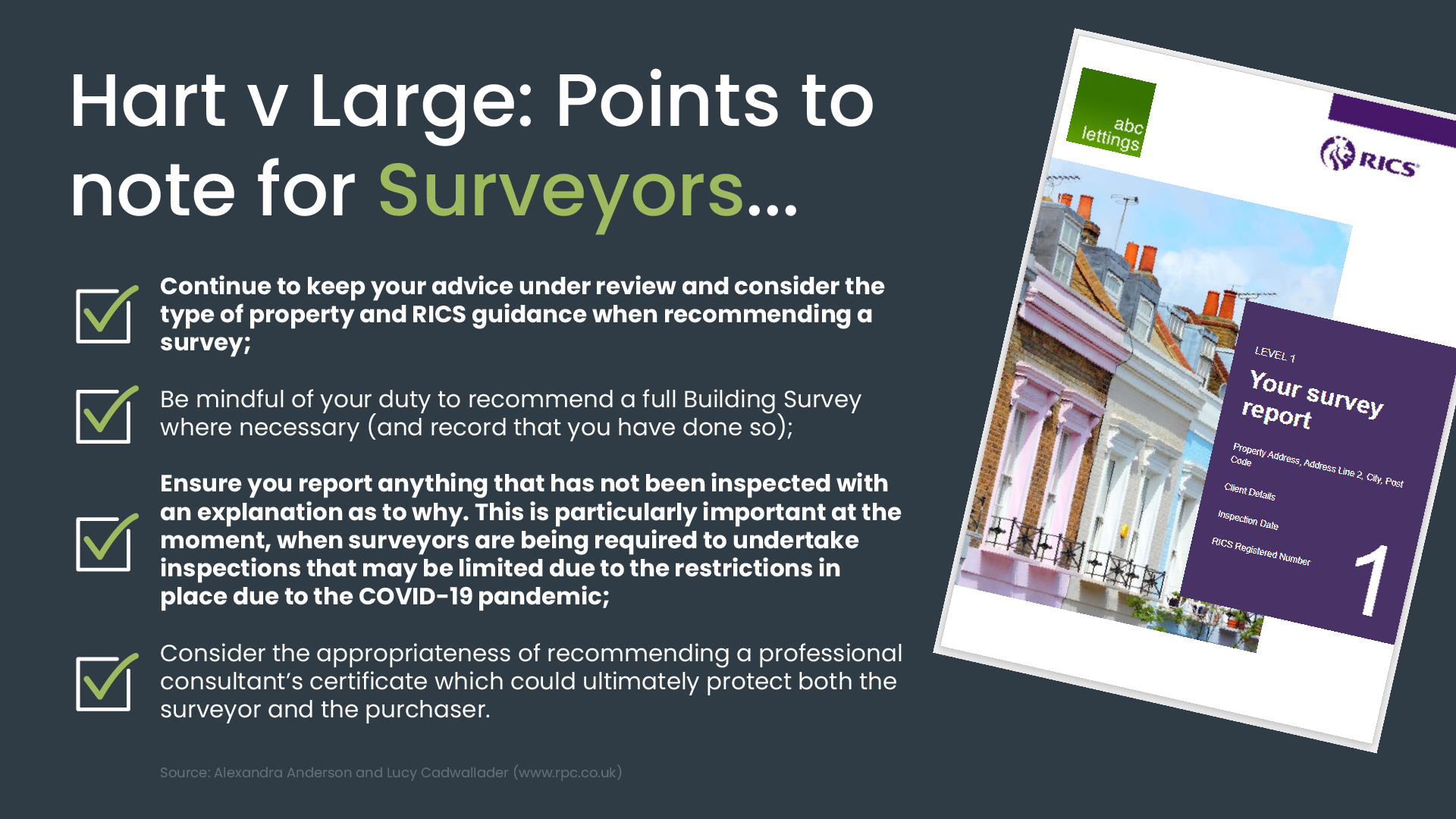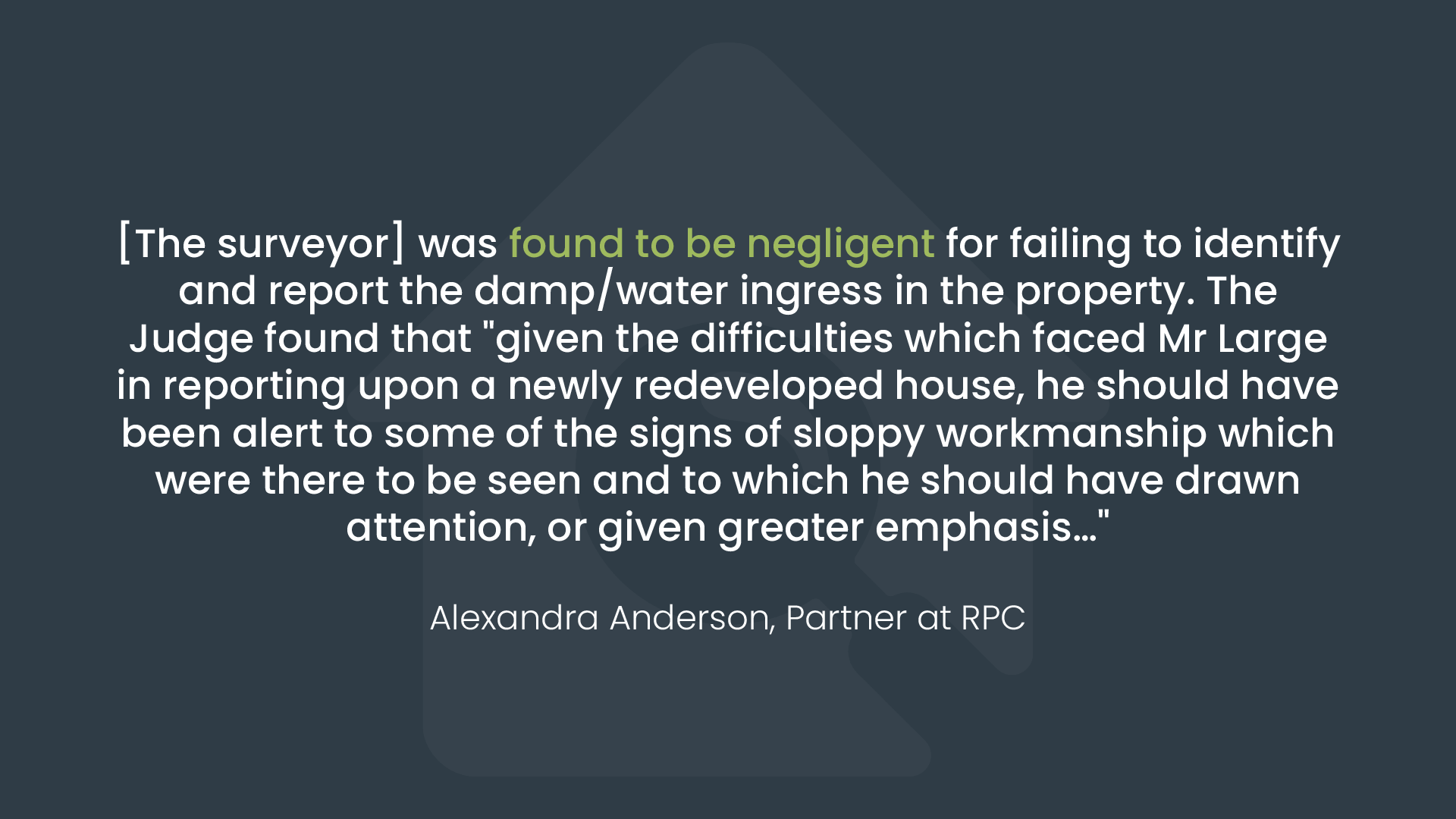
The recent judgment in Hart v Large, a dispute over a RICS HomeBuyer Report that led to significant remedial works, has highlighted further guidance for surveyors in the areas of compliance, including, among other things, the need for strong evidence capturing and documentation for auditing purposes.
Here’s a brief overview of the case.
In November 2011, a RICS HomeBuyer inspection and report was undertaken by an experienced surveyor, Mr Large. The property to be inspected, which is located on a hilltop in Devon, was newly constructed at the time. The surveyor had recommended a RICS level 2 HomeBuyer Report, and the prospective homebuyers Mr and Mrs Hart agreed.
The property was subsequently valued at £1.2 million and the surveyor’s report highlighted concerns with the pipes and guttering as well as drainage issues. The prospective homebuyers went on to purchase the property for £1.2 million after receiving Mr Large’s report.
After the purchase was complete, serious issues with water ingress and damp came to light. These things were not referenced in Mr Large’s report. As a result of the failure to highlight these defects, extensive remedial works were needed.
Alexandra Anderson, a Partner at RPC, is an insurance lawyer in the construction and surveying sectors. In a commentary piece, Anderson said that “the Claimants brought claims in negligence against the architects (instructed by the previous owners) who had supervised the reconstruction works, the Claimants’ conveyancing solicitors and Mr Large. The claims against both the architect and the solicitors settled prior to trial.”

A failure to identify significant issues
When it came to the surveyor, the claimants alleged that Mr Large’s recommendation of a Homebuyer Report instead of a full Building Survey was negligent. In addition to this, the claim was that the surveyor had failed to identify the “significant damp problems at the property”, and failed to recommend that a Professional Consultant’s certificate should have been obtained.
After reviewing all the evidence, the Court agreed that the surveyor should have indeed advised a Building Survey, stating that the surveyor has a “continuing obligation, having advised that a HomeBuyers Report is appropriate, to keep that advice under review (a) in the time between being asked to carry out a survey and reporting following that survey; and (b) as appropriate (a very important qualification) when advising after reporting on the initial survey…”
But the Judge found that surveyors’ opinions can differ, so this claim of negligence failed.
On point two, the Judge found that the surveyor was negligent for failing to identify the damp and water ingress, saying that the difficulties facing Mr Large when reporting on a newly redeveloped house should’ve alerted him to the signs of poor workmanship, which should’ve been noted in his report.
Despite this, the judge ruled that no evidence of damp was found at the property at the time of the inspection. Although recently rendered walls made it difficult for the surveyor to judge whether or not damp-proof membranes had been installed, Mr Large should have reported this impediment and advised on further investigations.
Regarding the need for a Professional Consultant’s Certificate, the surveyor was ruled against for failing to recommend such a certificate. Alexandra Anderson reported that “The Judge compared the importance of the Professional Consultant’s Certificate to a Completion Certificate from Building Control.”
In conclusion, it was found that the Claimants, had they known of the issues, would not have proceeded with the purchase of the property. The Judge awarded the Claimants £750,000, which was reduced to £374,000 to take into account the out of court settlement with the architect and the conveyancing solicitors.

Why compliance matters for surveyors
Key takeaways from this case are relevant for RICS APC and AssocRICS surveyors, especially those in the residential or valuation pathways. The findings are themselves relevant to the requirements set out in the RICS Home Survey Standard, which came into effect on 1st March 2021.
One point to consider, as per Anderson’s commentary piece on RPC, is that surveyors must ensure they report anything that has not been inspected, including an explanation as to why. Its significance has been felt recently, even more so, says Anderson, due to the limited nature of some surveying processes during and after the pandemic.
Additionally, some quarters of the surveying community have scrutinised the wording used in HomeBuyer reports. For example, when recommending a PCC, expert commentators urge the use of more forceful terms, such as ‘must’, instead of vague terms like ‘should’. While this may seem on the surface to be minor, its importance cannot be understated. Being mindful of the duty to strongly recommend things such as Professional Consultant’s Certificates, and evidencing such recommendations, is vital for protecting both the surveyor and the purchaser.
The importance of document retention for surveyors
Another point to consider is document retention, for which there is a legal obligation. After the service has been completed and the report has been delivered, following discussions with the clients, RICS members should ensure that their documentation is stored appropriately.
“Although this will depend on the RICS member’s own quality assurance procedures, it will usually involve assembling and updating all the relevant information and communications (hard copy and/or digital) and archiving in accordance with current practice.” the home survey standard states. “These should be securely stored and made available for future inspection if required. Legal liability may extend up to a maximum of 15 years in England and Wales but this may vary in Scotland and Northern Ireland.”
This is particularly relevant to the Hart v Large case because the evidence presented was retrieved from a report conducted a decade ago. While this may be difficult for practices lagging behind using outdated, paper-based methods, property inspection and operations software enables surveyors to keep detailed records of all evidence and reports compliant with data protection laws and home survey standard regulations. And as an RICS tech partner, Property Inspect has RICS compliant and branded Home Buyer reports built-in.
Increasing productivity and efficiency may be the difference between a failure to recognise defects and successfully capturing all pertinent evidence and information. Pre-configured, customisable templates greatly speed up the inspection process without compromising the integrity of the report, affording surveyors more time to make vital recommendations, maintain stellar client relationships and uphold all aspects of compliance.










